Acclaimed and Awards
Requiem pour un trompettiste
Saint Monica
I Was a Rat
Groundling Marsh
Gestus III—Historical Bliss
Alice Underground
The Country Wife
Requiem pour un trompettiste
Original 2005 Production, Costume Designer.
Auteur : Claude Guilmain.
Théâtre La Tangeante, Toronto.
"Les costumes de Valérie Chantal Kaelin dissent très fortement que nous sommes à l’époque du film noir avec ses hommes crapuleux et ses femmes mystérieuses. On pense à Humphry Bogart et compagnie."
Pierre Karch, « Du théâtre engagé…dans la bonne voie, » L’Express, Toronto, 27 septembre-3 octobre, 2005.
"Je tiens à te remercier pour ton souci des détails dans les costumes de Requiem. Tu as vraiment saisi l’atmosphère de la pièce et contribué à son succès."
Claude Guilmain, copie Collection « Fugues / Paroles » dédicacée.
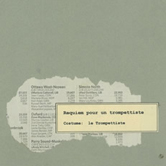
« Le Trompettiste.» Costume Dossier Cover. Le Trompettiste, 2005.. Each character design was presented as a folder. |
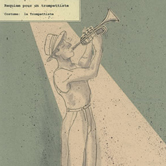
« Le Trompettiste.» Recto: Rendering. Le Trompettiste, 2005. Pen, ink and wash. |

« Mlle. Lalonde.» Recto: Rendering. Le Trompettiste, 2005. Pen, ink and wash. Two renderings were pinched during shopping trips. |
Link
Watch the video of Théâtre La Tangeante’s 2005 production
^ back to top of the page
Saint Monica
Toronto Art Director, Feature Film, 2001.
Under Production Designer, James Phillips.
Director: Terrance Odette.
Producers: Sienna Films, Day for Night Motion Pictures, Rave Films.
2002 Leo Awards; Official Selection: Toronto International Film Festival; Vancouver International Film Festival; Berlin Film Festival.
This beautiful film is an incisive, compassionate portrayal of working class Toronto. What an unusual pleasure to be working on a film that did not exploit the city as the representation of some other place. It was equally refreshing to see the Catholic community rendered on its own terms.
Since simulated children’s art always betrays an adult’s hand, I made arrangements with a local Catholic school to teach an art class in exchange for their art work. The teacher was happy: he had made a dentist appointment and anyway did not enjoy the messiness of delivering art classes. Primed with the synopsis of the film’s climax, the pupils set about their gouache paintings with enthusiasm: Without exception, the boys made action figures of St. Michael brandishing his sword at the Devil monster, while most girls drew pretty angels. One astute child at the developmental cusp of realism complained that they were uncertain how to portray the aerial perspective of their representation, saying it was not quite right, might I make suggestions?
Because an Iberian Assumption statue would not materialize in Toronto on time, let alone on budget, I designed one to be built by Brenda Goldstein. The Italian Saint Francis of Assisi Church had the most photogenic and tactically viable property while we used the inventory of the Portuguese Saint Agnes to create our fictional Church. In a shimmering moment during our consultation with the lay parade master, Antonio Raposo, during which, fag in mouth, he mimed out the needs of our storyline according to processional rules, I realized that he represented an extant scenographic lineage reaching back to the Middle Ages. “Who are your officials?” (Through translator.) “Officials?” “City Officials, of course. You must have officials. No? OK, we’ll find you some officials.”(Still through the translator.) His wife Eva materialized, winded and apologizing for her heart condition, to take us through the costumes.
In the midst of the cycle of prep and shoot, 9/11/2001 faded up to consciousness over the car radio on the way to work. When Our [Prop] Lady made her appearance on Grace Street, James, who had always been nervous about my theatrical coup d’état, called the office to say: “Valérie, I think we’re heroes; the ladies on the street are crossing themselves and saying ‘Bella! Bella!’” Mortified for feeling like an imposter, I phoned in the confession to my papa, who assured me that She only needed the priest’s sanctification to make good!
Wonderful producers; wonderful director; wonderful art department; unforgettable experience.

Poster. Saint Monica. Seville Films, 2002. |
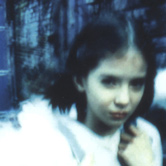
Poster (Detail of back). Saint. Monica. Seville Films, 2002 |
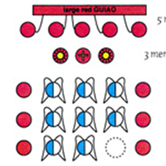
Parade Schematic, Revised. Informed by Antonio Raposo. Drawn by Cassandra Middlestead for Valérie Kaelin. Saint Monica, 2001. |
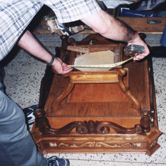
Laymen Measuring the Litters that Carry Andores (Precious Sacred Images). Saint Agnes Church. Grace Street, Toronto: 2001. |
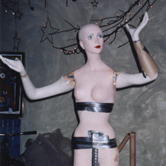
Our Lady’s Armature. Composite of Display Mannequins. Executed by Brenda Goldstein. Saint Monica, 2001. |
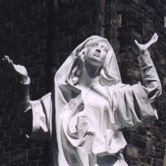
Our Lady of the Assumption. Executed by Brenda Goldstein. Mixed Media, High Gloss Enamel Paint. Saint Monica, 2001. |
^ back to top of the page
I Was a Rat
Canadian Art Director, Family Television Movie / Mini-Series, 2001-2002.
Under Production Designer, Venita Gribble.
Director: Laurie Lynd.
Co-Production: BBC Children’s Drama, UK; Catalyst Entertainment Production.
2002 DGC Awards Nomination in Recognition of Contributions as Art Director For Outstanding Achievement in a Television Movie / Mini-Series—Children.
Laurie Lynd Demo Reel > Family Reel > 4:30-9:15 min.
My role as art director in this film was largely tactical. Acting as a translator for the delightful British designer, Venita Gribble, meant (a) designing cost breakdowns in two currencies, (b) reminding her that the Canadian art department was not responsible for the grip package and therefore never to volunteer any part of our budget for it, (c) explaining that there would be no rubber flagstones to rent—she was much aggrieved to discover the cost of custom-injection moulds—and (d) covering for a succession of location managers. In addition I created Tapscrew’s country fair with Tom Bishop and Allan Westlake, made a portrait of a pompous media magnate and “etchings” for ludicrous British tabloids, and retrofitted heritage sites as best we could to meet the expectations of a venerable European nation. I detailed a gazebo to resemble an ornate cage for the ingénues as love birds. The assignment was a window on British scenographic practices. For British films, as in our North American stage environment, set decorations are considered part of the prop inventory.
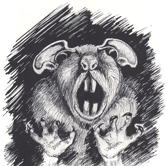
Rat. Graphic Art for Tabloid Prop. I Was a Rat. 2001-02 |
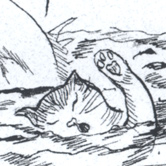
Woman Swims with Cat! Graphic Art for Tabloid Prop. I Was a Rat. 2001-02 |
|
^ back to top of the page
Groundling Marsh
Art Director, Seasons I, II, III; Set Designer Seasons II & III, 1993-95.
Under Production Designer, Marian Wihak.
Producers: Portfolio Film and Television, J. A. Delmage Productions.
Co-winner, Gold Medal for Art Direction, The New York Festivals, 1994.
Link to what appears to be a Season II Trailer
I am grateful to Production Designer, Marian Wihak, for making me her art director on the project. Once she had created this magical world using her previous experience on Fraggle Rock, she entrusted that “precious child” to me, as she took on other projects. I served three seasons: 39 episodes. Our friend, Pat Flood, completed the last 26.
Hegdish’s Lair, the kidney-shaped water pans and the working waterfall are my creations. All photographs, maquettes, drafting are my own. The Seasons are indicated henceforth as “GM-I” and if episode specific: “Ep-I”. Many talented and warm human beings contributed to the Groundling vision that gathered a force all of its own, telling us what it needed. Thanks especially to Joe Madziak, Construction Manager; Hubert Peddle, On Set Carpenter and Cascade Operator (!); Jocelyne “Emma Peel” Senior; Set Dresser; the indomitable Jeff Mawle, Prop Master and the ingenious twins Jim and Geoff Murin as Assistant Prop Builders; and Sidney J. Sproule, Puppet dresser.
Hegdish’s Lair and His Trees
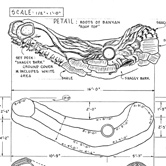
Hegdish’s Lair. Ground Plan. GM-II, 1994. |
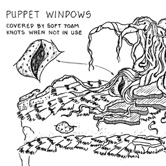
Hegdish’s Lair. Elevations and Sections. GM-II, 1994. |

Mudslinger’s Armature. Wood, Stationary. GM-I, 1993. |
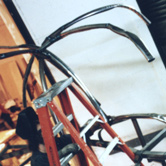
Hegdish’s Lair Armature. Steel, with casters. GM-II, 1994. I convinced the production that casters and sturdy joints would offset the weight of steel pipe armatures, making set changes more easeful. |
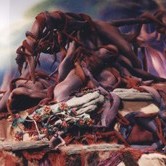
Hegdish’s Lair, Clad, Painted and Dressed. GM-II, 1994. |
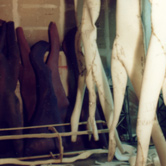
Hegdish’s Trees. Sign-curved patterns cut from aerated foam. My draping experience at FIT and props apprenticeship with David Manwaring in NYC came together to solve the problem. |
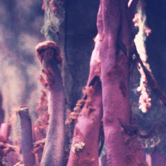
Hegdish’s Trees upright. Aerated foam finished with extruded foam, painted and dressed. GM-II, 1994. |

Hegdish’s MegaBoo Hoax in the Making. GM-III, 1995. Construction drawings got very earthy in the heat of creation! |

Hegdish with MegaBoo Feet. GM-III, 1995. Puppet by New York’s 3D Design. |
Water Effects
Generally, I invented the water effects by breaking the taboos of “flaring” to video. As concerns reflecting pans, I had a great teacher, Lighting Director, Barney Stewart. The effects included tossing aurora borealis sequins to portray splashes and water droplets, kidney-shaped, modular water pans and a working cascade. For GM-II, Ep. 15: “Butterfly Day,” the director gave us the morning to configure the pans before the crane camera to create a vista of the Marsh. It was thrilling. And finally, it fell on me to imagine how to make GM-I’s previously static, upstage cascade functional. After studying images of water, display models and spiraled metal Christmas pendants, the solution flashed as I opened a package of cellophane-wrapped okra. The moving parts needed to rotate horizontally, not vertically! The camera men were so impressed they urged me to patent the machine. No, I said, scenic water machines have been in the public domain since the Renaissance. I am only channeling, vaguely remembering one that resembled a vintage, fabric-toweling dispenser. In Season III, the Murin twins managed to get all the rollers moving downward. It was operated by peddling its covert identity: that of a stationary bicycle.

Water Pan. Construction Drawing. GM II, 1994. |

Water Pan for the Crystal Cave. GM III, 1995. |
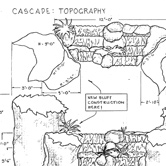
Cascade. Orthographic Drawings, 1/2. GM II, 1995. |
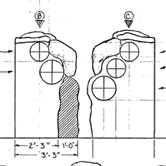
Cascade. Construction Drawings, 2/2. GM III, 1995 |

Cascade. Marsh Upstage. GM II, 1994. |
|
The Crystal Cave, Season III
I designed the Crystal Cave in its entirety for an interactive film pre-show commissioned by a theme park in the Edmonton Mall. “Crystal” and her cave were integrated into the GM III repertoire. Later, a presentation model and production photographs were exhibited by invitation at the Toronto Library Picture Collection where I, like so many artists and designers, begin my visual research.
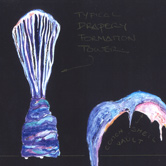
Crystal Cave. Detail of a Painted Elevation for Accessories. GM III, 1995. |
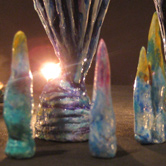
Drapery Towers. Presentation Maquette. Macro-Photo by Danielle Grattage. |
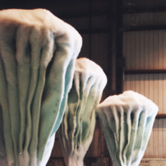
Drapery Towers, Prior to Extruded Foam. GM III, 1995. |
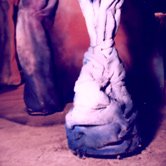
Drapery Tower, completed. GM III, 1995. |
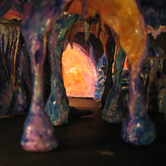
Cave Arches. Presentation Maquette. Macro-Photo by Danielle Grattage. |

Cave Wall Schema. Presentation Maquette. Macro-Photo by Danielle Grattage. |
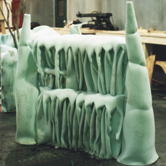
Stalagmite Prior to Extruded Foam. GM III, 1995. |

Stalagmite completed. GM III, 1995. |
|
^ back to top of the page
Gestus III—Historical Bliss
Costume Designer, 1984.
Director: Michael Springate
Photography: Brian McNeil
…the costumes, including a stunning, blazing kimono, are by professor Valérie Kaelin.
The Thursday Report, April 12, 1984.
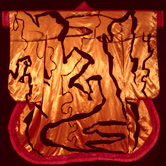
Kimono. Dyed Kasha Cloth, Trapunto Tafetta, Foam and Tafetta Omelet Edging, Acrylic Paint. Gestus II—Historical Bliss. 1984. Photo: Brian McNeil. |
|
|
^ back to top of the page
Alice Underground
Scenographer, Set Designer.
Auteur: Gerry Gross
Costumes: Carole Baillargeon, maintenant Directrice générale de la Maison des métiers d’art de Québec
Lighting: Céline Perron, now professor for the Department of Dance and Theatre
at Keene State College, New Hampshire
Staff Technical Director:
Roger Parent, who went on to Cirque du Soleil.
Staff Costumière: Maggie Ewing, well-known cutter of the time. Now translator.
What gives the evening its magic is the incredible environmental set designed by Concordia professor Valérie Kaelin. A tangled curtain of net and tree roots which covers three walls and part of the ceiling, then opens into marvelous sub-stages for the dramatic scenes, it’s one of the most imaginative sets I’ve seen in ages.
Marianne Ackerman, “Incredible set turns this Alice into magical, surreal evening,” The Gazette, Montreal, Thursday, December 12, 1985.
Thank you, dear Gerry, Roger, ingenious crews and prankster cast for this still palpable joy.
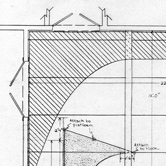
Alice Underground. Root Walls: Ceiling to Ground Plan. 1985. The walls were drops cut from erosion cloth. Both the top and the bottom of the drops were lashed to battens, the ones at the bottom bolted to the floor. The curved openings were bound with muslin casings through which airplane cable was pulled in tension as a sail might be. The kapok-filled pantyhose roots were tied to the drops prior to rigging. Wobbler that I am, I was gleefully pushing off the black box walls to secure the canted curves with the rest of the crew of would-be sailors. |
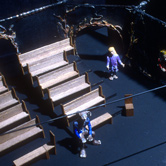
Alice Underground. House View. Maquette. 1985. |
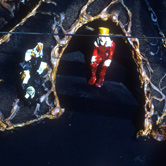
Alice Underground. Stage Right. Maquette. 1985. |
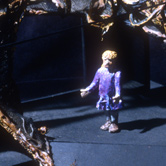
Alice Underground. Stage Left. Maquette. 1985. |
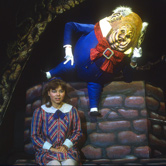
Alice Underground. Humpty-Dumpty’s Pop-Up Set. 1986. Costume: Carole Baillargeon, with Maggie Ewing. Humpty: Robert Mancuso. Alice, Humpty-Dumpty: Bob Paquette. |
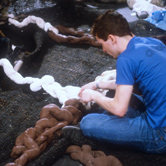
Alice Underground. Root Walls: Erosion Cloth soaked in Borax. Kapok-filled panty-hose. 1985. |
^ back to top of the page
The Country Wife
Costume Designer. Concordia University, 1983.
Director: Ralph Alison.
Set Design: Bill Reznicek. The set strange to perfection!
Lighting Design: Roger Parent
Assistant Costume Designer: Beverly Zawitkoski
Costumière: Gayle Larson
Traces of Basile, Armani, Bill Blass, Yves Saint Laurent, Vivienne Westwood.
Makeup to rival the best of Kiss.
Hairstyles that put the city’s most outrageous coiffeurs to shame…
The clothes and accessories are superb…
Fashion fans should see their work [Kaelin, et al] for the fun of it...and to appreciate the fine art of parody.
Iona Monahan, “Restoration comedy gets new-wave look,” The Gazette, Montreal, Tuesday, February 15, 1983.
Featured: Allô Boubou. CBC Montréal.
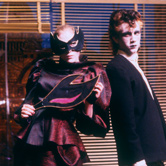
The Country Wife. Hamish McEwan as Horner and Louyse Leonard as Lady Jasper Fidget in Act I- Scene 1. 1982. |
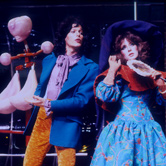
The Country Wife. Actor Paul Slakov as Harcourt and Meg LaBelle as Alithea in Act III-Scene 2. 1982. I still wish her skirt were “New Look”-length. Never believe someone who maintains that sight lines affect the length of a hem. |
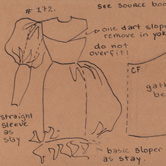
The Look, Construction |
^ back to top of the page
To Cite Works of this Gallery
Please exercise the courtesy of mentioning my collaborators. It means a lot to them.
|

